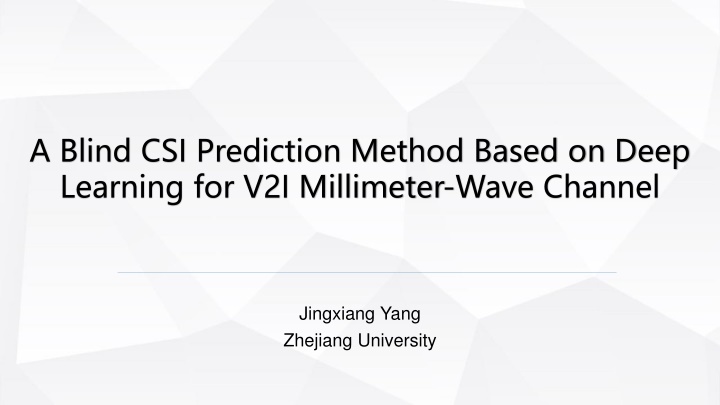
Blind CSI Prediction Method Based on Deep Learning for V2I Millimeter-Wave Channel
Explore a blind CSI prediction method utilizing deep learning for V2I millimeter-wave channels. The research delves into the application of 5G in vehicular communication scenarios, the sensitivity of mm-wave wireless systems, MEC and ACM technology, channel estimation techniques, and future CSI prediction utilizing CNN and LSTM.
Download Presentation

Please find below an Image/Link to download the presentation.
The content on the website is provided AS IS for your information and personal use only. It may not be sold, licensed, or shared on other websites without obtaining consent from the author. If you encounter any issues during the download, it is possible that the publisher has removed the file from their server.
You are allowed to download the files provided on this website for personal or commercial use, subject to the condition that they are used lawfully. All files are the property of their respective owners.
The content on the website is provided AS IS for your information and personal use only. It may not be sold, licensed, or shared on other websites without obtaining consent from the author.
E N D
Presentation Transcript
A Blind CSI Prediction Method Based on Deep Learning for V2I Millimeter-Wave Channel Jingxiang Yang Zhejiang University
Contents 01 01 05 05 Introduction Conclusion 04 04 02 02 System model 03 03 Simulation results Channel prediction model
Research Background Present works Introduction Our works
Research Background The application of 5G in vehicular communication scenarios. The high sensitivity of mm-wave wireless system to channel quality and environmental conditions. The application of MEC and ACM technology.
Present works Channel estimator: Date-aided: maximum-likelihood (ML) estimator squared signal-to-noise variance (SNV) estimator Blind: second- and fourth-order moments (M2M4) estimator Channel prediction: Yadan Zheng proposed a modified ARIMA model for channel quality indication (CQI) prediction to solve the long delay problem in satellite environment. G. Liu used long short-term memory (LSTM) network to predict SNR. C. Luo proposed an OCEAN model to predict CSI in 5G wireless communication system.
Our works Blind channel information prediction model based on deep neural network(BCPMN): Fast-varying channel model No pilot required CNN and LSTM used Future CSI prediction
System model V2I V2I high speed vehicle low speed vehicle Fig. 1. Typical V2I communication scenarios of high speed train environment and highway environment.
System model The received signal model: 1 L = + ( ) r k ( ) ( l s k ) ( ) n k h k l l = 0 l where k represents the index of sample in time domain. s(k) is the transmitted signal and n(k) is the Gaussian noise. L is the number of multipath, and hl(k) is the lth multipath channel model. When l = 0, h0(k) is the LoS path as below LoS K x x = 2 j f kT 0( ) h k e d s + 1 LoS K 0.423 f vf c = T = c f c d d
System model The objective function: 2 = argmin ( ) G n f R N L 2 , , f N L where n is the true SNR value, f represents the function that the neural network needs to fit, R is the received data matrix and is the matrix dimension. the received signal sequence after data preprocessing. N L R is the matrix obtained from N L
Data Preprocessing Channel prediction model The BCPMN
Channel prediction model The flow chart: Received Signal Prediction Result Cache and Reshape Truncation BCPMN 1D 1D 2D Data Preprocessing Data Dimension Fig. 2. The flow chart of the model. The model includes a data preprocessing module and a deep neural network prediction module
Data Preprocessing The 1-dimensional data of t0-th frame is converted into a 2-dimensional matrix in the data preprocessing scheme: Time Time Ft-N+1 Ft-2 Ft-1 Ft L L Sample Sample ??= ??,1,??,2, ,??,?, ??0 ?+1,1??0 ?+1,2 ??0 ?+1,? T,??TT T ??= ?? ?+1 , ,?? 1 Frame Data Frame Data ??0 1,2 ??0 1,? ??0 1,1 Truncated Data Truncated Data R Rt t ??0,1??0,2 ??0,? ? Input Data Matrix Input Data Matrix Time Time Fig. 3. The data preprocessing scheme.
The BCPMN The BCPMN model contains of 2 convolutional layers, 4 LSTM layers and 2 fully connected layers 2 2D D Convolutional Convolutional layer layer LSTM layer LSTM layer Fully Connected layer Fully Connected layer Fig. 4. The structure of the BCPMN.
Simulation results We use the normalized mean square error(NMSE) to calculate the error between the predicted value and the true value. The definition of NMSE is as follows = 2 n ( ) ( ) y i y i p t = 1 i NMSE n 2 ( ) y i t = 1 i p y ty where the ratio of training set, verification set and test set is 0.8, 0.1, 0.1 respectively. is the predicted value and is the true value. The dataset size is 20000 frames and
Simulation results Fig. 5. SNR prediction results and NMSE at different vehicle speeds.
Simulation results Fig. 6. The comparison of prediction performance between LSTM, OCEAN and BCPMN under different SNR
Simulation results Fig. 7. Adaptability experiment of BCPMN model to QPSK, 16QAM and 16APSK modulation modes
Conclusion A blind channel information prediction model based on deep neural network(BCPMN) in mm- wave wireless communication system. Fast-varying channel Data preprocessing method Compared with LSTM and OCEAN
